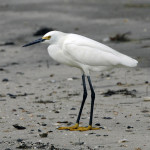• • •
Snowy Egrets look as though they’ve accidentally stepped in a pool of yellow paint. Their legs are black down to their ankles and then suddenly turn a bright yellow at their feet.
• Length: 24 inches
• Wingspan: 41 inches
• Season: Year-round
More about Snowy Egrets.
Where they are, and when.
They are much smaller than a Great Egret, with a yellow face and a shorter, narrower bill that is black instead of yellow. The juvenile Cattle Egret is similar but much smaller. Its bill turns yellow as it gets older, and it has a distinctive orange bill, plumes and legs when breeding. The white morph of the Reddish Egret is much larger, has pale gray legs and develops a pink bill in its second year.
Snowy Egret forage alone or in loose flocks with other egrets and herons, feeding mostly on small fish, crab, shrimp and insects. It can walk slowly and deliberately in the shallows like other wading birds or dart and hop about frantically, using its feet to stir up prey. It forages not only in freshwater ponds, streams and wetlands but in the gentle surf along the shoreline. Unlike some of its cousins, it sometimes feeds on insects from the air or skims fish from the water.
During breeding season, their faces turn a bright red and they develop wispy white plumes on their lower back, breast and neck. The males are quite the dandies in their breeding displays, puffing up the plumes around their head, neck and back in Peacock fashion.
Snowy Egrets build their nests in large colonies with other egrets and herons. Their nest is a platform of sticks in a tree or shrub above the ground and contains two to six pale blue-green eggs.
They are year-round residents on the Texas Coast but are more common in spring and summer as some populations migrate north from Mexico and Central America.







You must be logged in to post a comment.